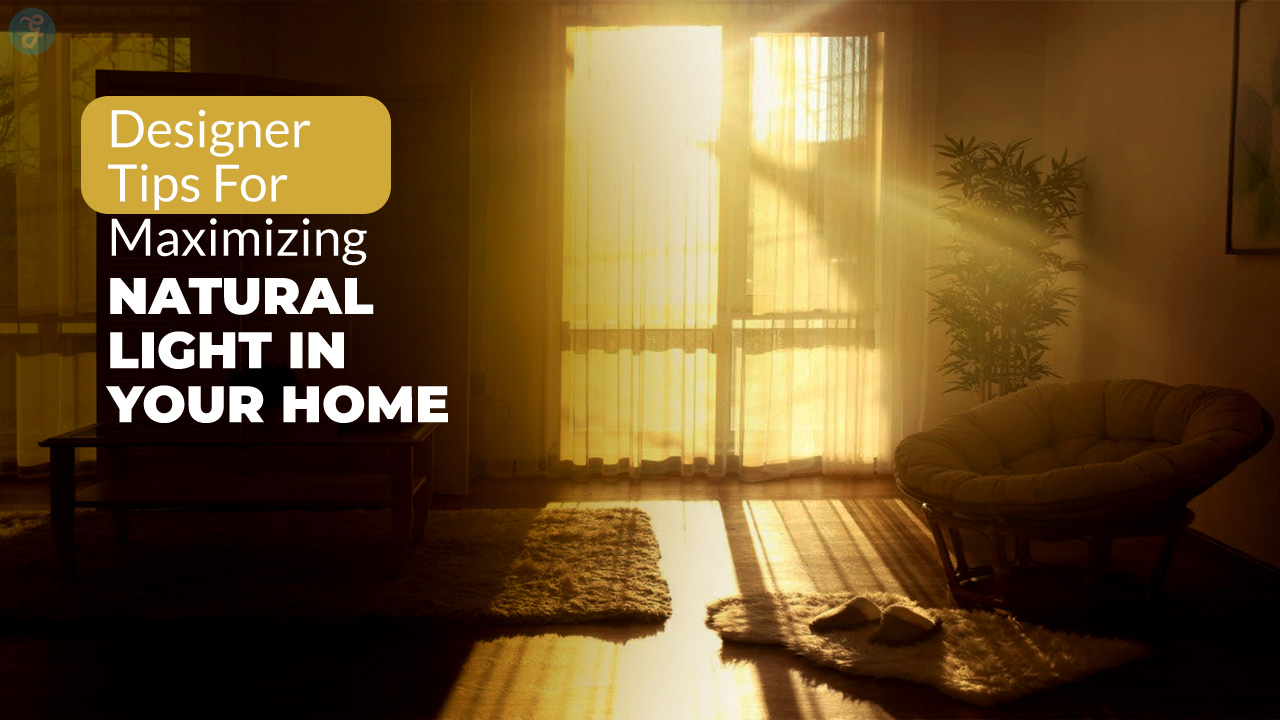Are you struggling with dark, dull rooms? Natural light can brighten your home and improve your mood, productivity, and even health by boosting vitamin D levels. This post will provide 8 designer tips to optimize natural light in your home without exceeding your budget.
Are you ready to brighten up your space? Keep reading!
Position Mirrors Strategically
Place mirrors directly across from windows to double the natural light in a room. This simple trick bounces sunlight back into the space, brightening it instantly.
Hang a large mirror in dim corners or narrow hallways to draw light into darker spots. Mirrors also make rooms feel bigger by creating an open illusion. Choose designs with slim frames for less distraction and more reflection.
Use this method, and even gloomy spaces will seem lively and airy!
Opt for Sheer Window Treatments
Sheer window treatments let sunlight flood your space. They brighten rooms without blocking views. Unlike heavy drapes, sheer fabrics soften light but don’t darken the room. This technique creates a cozy yet airy feel.
Light materials boost natural light and evoke positive emotions.
Choose white or pastel sheers for maximum effect. These allow more sun to pass through compared to darker shades. Pair them with roller blinds if you need privacy at night. Sheer curtains are an easy way to enhance home design while making rooms feel open and inviting!
Incorporate Light-Reflecting Materials
Glossy surfaces and metallic finishes can reflect sunlight beautifully around a room. For instance, a mirrored coffee table or polished metal light fixtures enhance natural light while adding style.
Even small touches, like shiny vases or frames, illuminate dark corners.
Light-colored paints reflect over 80% of sunlight onto walls and ceilings. Combine these with reflective artwork to distribute light across your home. A glossy backsplash in the kitchen reflects daylight and adds depth to the space without creating clutter.
Choose Light and Neutral Paint Colors
Soft whites and pastels brighten rooms by reflecting more natural light. Colors with high Light Reflectance Values (LRV) work wonders in making spaces feel bigger and airier. A fresh coat of neutral tones, like beige or soft gray, diffuses sunlight evenly across walls.
Light colors also create a calm atmosphere that suits any room. They pair easily with other décor while keeping your home design timeless. For maximum brightness, pair these shades with reflective materials or glossy finishes sparingly.
Use this trick in living areas to reduce the need for artificial lighting during the day!
Install Skylights or Tubular Daylighting Devices
Skylights and tubular daylighting devices brighten rooms by channeling sunlight inside. Tubular skylights, also called solar tubes, are smaller than traditional skylights but deliver remarkable results.
They capture outdoor light and reflect it into your space with notable efficiency.
Installing these can be quick. Professionals often finish the job in 45 minutes, though DIY installations may take up to one day. Unlike large skylights, solar tubes are cost-effective and energy-efficient—perfect for tight budgets or tricky roof spaces.
These additions reduce reliance on artificial light and enhance the charm of hallways, closets, or bathrooms that lack windows.
Arrange Furniture to Allow Light Flow
Avoid placing bulky furniture close to windows. Large pieces can block sunlight and create dark corners. Instead, position sofas or chairs away from light sources. This approach keeps pathways for natural light open.
Observe how sunlight moves through your home during the day. Use that knowledge to arrange items like tables or shelves without stopping light flow. A clear path boosts brightness while making spaces feel larger and more inviting.
Use Glass Doors or Partitions
Glass doors connect spaces without blocking light. Sliding glass doors open homes to outdoor areas, creating a seamless flow with nature. Inside the home, partitions made of glass divide rooms while preserving an airy and bright feel.
They let sunlight pass through freely, reducing the need for artificial light.
Low-E glass boosts energy efficiency by cutting heat transfer but keeps visible light strong. It balances natural beauty and practicality in your home design. For example, a clear partition between the kitchen and living room ensures openness while controlling noise or smells effectively.
Minimize Heavy Window Coverings
Thick drapes block natural light and create shadows. Swap them for sheer curtains or light-filtering solar shades. These let sunlight pour in while still giving privacy. Heavy window coverings also trap dust, making cleaning harder.
Removing bulky treatments near windows creates a clean look and improves airflow. Try blinds or Roman shades that tuck neatly away when open. This technique keeps rooms brighter without extra clutter stealing the show from your interior design choices.
Replace Solid Doors with Glass-Panel Alternatives
Glass-panel doors brighten spaces instantly. They allow sunlight to flow between rooms, creating an open feel. French doors work wonderfully for this purpose—stylish and practical. Swapping solid doors for glass adds depth while maximizing natural light.
These options also improve home design aesthetics. Frosted glass offers privacy without blocking light completely. Use clear panels in shared spaces like living areas or kitchens to enhance light reflection throughout your home.
Keep Windows Clean for Maximum Light Entry
Dust and grime on windows block natural light. Clean glass lets the full spectrum of sunlight shine into your home, brightening every corner. Sparkling windows enhance brightness and create a warm, inviting space for all.
Professional cleaning or regular wiping removes dirt that builds up over time. A clean surface improves visibility and maximizes light transmission throughout the day. Don’t let smudges diminish your interior design efforts—clear panes make all the difference!
Add Light-Colored or Reflective Flooring
Light-colored floors bounce natural light around the room. Options like oak, maple, or whitewashed wood create an open feel. Tiles with a glossy finish also reflect sunlight beautifully.
Even polished concrete can brighten spaces if sealed with a reflective coat.
Carpets in pale tones can help too. Textures like low-pile rugs in beige or cream work wonders. Pair these choices with light walls for maximum effect. Small changes in flooring color make rooms feel larger and brighter instantly!
Experiment with Glossy Finishes (Use Sparingly)
Glossy finishes bounce natural light, making spaces feel brighter. A shiny backsplash in the kitchen or a glossy accent wall can do wonders without overdoing it. Use these sleek surfaces sparingly to avoid overpowering the room’s design.
Pair glossy elements with matte textures for balance. For example, combine a polished dining table with soft linen chairs. This mix keeps the look stylish and understated while still enhancing the room’s illumination.
Use Light-Filtering Solar Shades
Light-filtering solar shades soften sunlight while keeping your home bright. They reduce glare and maintain a warm, inviting feel. These shades allow natural light to flow in without harshness, creating a calm ambiance indoors.
They also help manage heat gain, cutting energy costs during sunny months. Perfect for living rooms or kitchens, these shades balance light and privacy effortlessly.
Expand Open Floor Plans to Reduce Walls
Knocking down walls can invite sunlight to flow freely through your home. Open floor plans create a cohesive space for natural light to spread, making rooms feel bigger and brighter.
Removing barriers like partitions or bulky dividers can turn shadowy corners into sunlit spots.
Use fewer walls near main windows and doors to let sunlight travel farther inside. For example, combining the kitchen, dining room, and living area into one large space maximizes illumination.
This simple change enhances brightness while modernizing your home design with ease.
Replace Small Windows with Larger Ones
Larger windows brighten your home instantly. South-facing walls with big windows let in the most sunlight, warming and lighting rooms naturally. Such illumination reduces the need for artificial light during the day, saving energy.
Think of spaces like living rooms or kitchens—perfect spots for extra light. Modern double- or triple-pane glass keeps cold air out while letting sunlight flood in. A well-lit room feels more open, cheerful, and welcoming.
Decorate with Light-Colored Artwork or Décor
Light-colored décor makes spaces feel brighter and more open. Hang artwork with soft, neutral tones like whites or pastels to reflect natural light. Add cream vases, beige pillows, or white-framed photos to enhance brightness in a room.
Using pale furnishings amplifies light flow. A light-colored rug or throw blanket can soften shadows while making the room appear larger and airier. Light hues help balance darker furniture without overwhelming small spaces.
Place Plants Near Windows to Highlight Natural Light
Houseplants flourish near windows, especially those facing south. These areas provide strong natural light, promoting plant growth and vitality. Bright light within 3 feet of west- or south-facing windows works well for many species.
Placing plants close to these windows boosts their growth and improves your home design. A vibrant monstera or cheerful pothos highlights sunlight streaming in, adding energy to the space.
Turn pots each week so all sides receive sunlight equally. Maintain clean sills and avoid large furniture nearby to keep the light unobstructed!
Avoid Bulky or Dark Furniture Near Windows
Large, dark furniture near windows blocks sunlight like a wall. A bulky couch or cabinet can turn your home into a cave, stealing that natural glow. Use light-colored and slim furniture instead to keep the sunshine flowing through freely.
A small table in soft wood next to the window lets daylight scatter beautifully across the room. Heavy drapes are not welcome either; they hog too much space and dim everything down.
Keeping it open and airy should be your goal!
Incorporate Mirrors in Hallways and Dark Corners
Mirrors bounce natural light around, turning dark hallways and corners into brighter spaces. Placing a large wall mirror near a window can double the amount of sunlight entering the area.
Smaller mirrors work well too—use them in clusters for an artistic touch while still reflecting light.
Dark corners feel less gloomy with strategically placed reflective surfaces. Try hanging mirrors opposite lighting fixtures to enhance brightness even at night. They also create an illusion of depth, making tight spaces appear larger than they really are.
Use Multi-Pane Windows to Distribute Light Evenly
Multi-pane windows brighten rooms by breaking light into smaller, even sections. This design softly spreads sunlight, reducing shadows and dark corners. Homes with large spaces benefit most, as light reaches every nook naturally.
Proper placement of these windows boosts both style and function in your home design. They also improve insulation, keeping rooms comfortable while cutting energy costs. For a clean look with maximum natural light, consider adding multi-pane options to living or dining areas!
Takeaways
Bringing more sunlight into your home isn’t just about beauty; it’s about boosting your mood and well-being. Small changes, like mirrors or lighter paint, can make a big difference.
Light fills a space with warmth and life. So, embrace the sunshine, play with reflections, and let your home shine bright every day!
FAQs on Tips For Maximizing Natural Light In Your Home
1. How can I maximize natural light in my home?
Use wall mirrors to reflect sunlight, install glass doors, and choose glossy finishes for surfaces. These tricks bounce light around your space.
2. Do interior design choices affect natural light?
Yes, lighter paint colors and minimal furniture help brighten rooms. Cabinets with reflective finishes can also enhance light reflection.
3. What role do artificial lights play when maximizing natural light?
Artificial lights like LED bulbs complement daylight by filling darker areas at night or on cloudy days without overpowering the room’s brightness.
4. Are there specific materials that work best for increasing natural light?
Glass doors and large windows are ideal for letting sunlight in. Glossy surfaces amplify this effect by reflecting more of it across the room.
5. Can maximizing natural light improve moods or energy levels?
Absolutely! Sunlight boosts moods, makes spaces feel open, and even helps regulate sleep patterns—perfect for creating a positive atmosphere indoors.








































